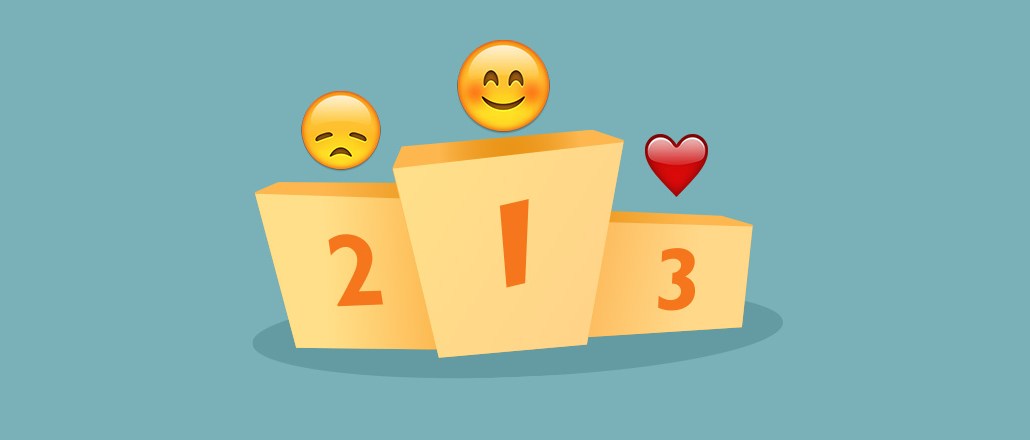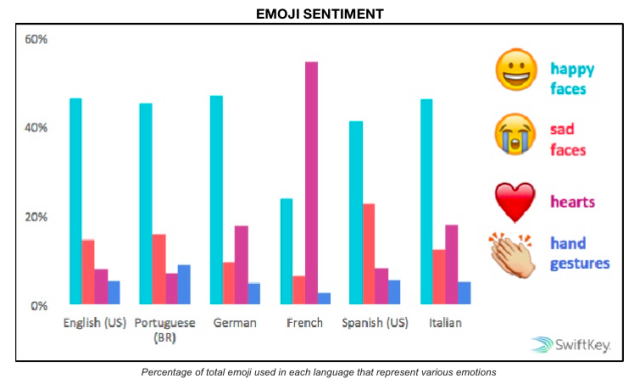Save 50% on a 3-month Digiday+ membership. Ends Dec 12.

It’s been another big week for emojis.
First, news leaked that the first major Microsoft emoji update is finally forthcoming. But the fact that emojis are, like, everything right now wasn’t groundbreaking. What raised eyebrows was that the new racially diverse suite of little icons includes one of an upraised middle finger. At long last, you can text someone the bird. If you’re using Windows 10.
Instagram also came through this week by finally allowing people to use hashtags with their favorite emojis. #![]()
“Every technology on social media is first embraced by the younger generation,” said Christian Brucculeri, CEO of native advertising platform, Snaps. “But the cultural obsession with visual communication right now transcends generations — my mother uses emojis.”
But those of you Gen-Xers and Baby Boomers who can’t tell the smiley face emoji from the smirking face emoji, fear not. Here’s your emoji primer, with everything you need to know about these graphic representations and why they are so big.
What is an emoji?
The emoji was born when typographic displays of a facial representations — you know, emoticons ;) — evolved into full-fledged graphic pictorial representations. They were created in the late 1990s by NTT DoCoMo, a Japanese communications firm and are regulated by the Unicode Consortium, a nonprofit corporation that standardizes software and the representation of text internationally.
How many are there?
A lot. There were a total of 722 emoji characters available in the standard Unicode 6.0 character set — the standardized list of text code that translates into emojis — shared across platforms until July last year, when 250 new emoji characters were released as part of the Unicode 7.0 update. The Unicode 8.0 update is expected to be released sometime this year and will include emojis with a diversity of skin tones. The range of skin tones for emojis that Apple recently introduced on iOS and OS X is based on the standards that the Unicode Consortium has proposed for Unicode 8.0.
While the underlying code of, say, the smiley face emoji :) is the same on Google chat as it is in Instagram, emojis render differently on different platforms. So, the “dancer” emoji looks like a flamenco dancer on Apple, Instagram and Facebook, but is a man wearing a yellow suit with his hand raised on Google. Microsoft, on the other hand, is all set to abandon the traditional yellow emojis instead making them all gray and thereby race-neutral.
How much do people love emojis?
Again, a lot. People absolutely ![]() emojis.
emojis.
According to research from eMarketer, there are 2 billion smartphone users worldwide. On those devices, some 41.5 billion messages and 6 billion emoticons or stickers are sent around the world every day on mobile messaging apps, according to branded digital startup Swyft Media.
Instagram’s decision to enable the hashtagging of emojis was also prompted by numbers — with nearly half of all Instagram posts containing at least one emoji.
Snaps, which also creates custom emoji suites for brands, has even seen branded emojis resonate among fans. The company, which created the chicken fries emoji for Burger King, for example, reports that 3.6 million emojis have been shared across the different branded keyboards it has created.
“Given that users are on the same playing field using the same social and messaging platforms every day, there is a desire these days to express ourselves in a more unique manner than just text,” said Andrew Cunningham, Huge’s social lead.
Which ones are the most popular?
It depends. London-based keyboard app firm SwiftKey recently analyzed more than 1 billion sets of emoji data, covering 800 emoji across 60 categories — with interesting results.
Overall, happy faces were the most popular category across all regions, comprising nearly 45 percent of emojis sent. Sad faces were the second-most popular emoji category, followed by hearts (which lumps together various heart colors as well as the broken-heart emoji).

Country-specific data revealed that the French are the most amorous, sending more hearts than any other region, while Americans use LGBT-related emojis like the rainbow, men holding hands or women holding hands 30 percent more than the rest of the world. Australians love their booze, using double the average amount of alcohol-themed emojis. Yay, stereotypes!
So have emojis replaced Internet slang?
Sort of! The recent Instagram study found that people align the meanings of popular emojis with early internet vernacular. For instance, the face with tears of joy face is commonly understood to mean the same as “lol,” “lmfao” and “lmao,” whereas the thumbs-up emoji implies “keep it up” or “good job.”

“The vocabulary of Instagram is shifting similarly across many different cohorts with a decline in Internet slang corresponding to a rise in the usage of emoji,” said the post by Instagram.
Is this why I’m seeing these things in more commercials now?
Emojis present brands with an opportunity to convey their messages even more creatively, which explains the ineluctable emojification of brands. They are not only using emojis in their daily communication with fans on social media, but several are also commissioning custom emoji keyboards specific to their brands.
Time Inc.’s Food & Wine magazine, for instance, is soon launching its own suite of emojis, dripping with with cake slices and champagne glasses.
“Since our avid fans actively communicate with standard emojis all the time — some going as far as writing entire restaurant reviews in emojis — we wanted to create a whole new world of possibilities for the super foodie connecting the images with the objects of their obsession,” said Dana Cowin, editor-in-chief of Food & Wine.
Agencies have gotten in on it too. Scott Wolf, copywriter at McCann, created “Admojis” — emojis with one-liners that poke fun at ad agency life. And Swedish agency Dogwash launched Advertising Emojis, a suite of 70-plus ad-themed emojis.
Who’s keeping track of all this, anyway?
Apart from Instagram and SwiftKey, there are several companies that closely monitor everything emoji-related. Emojipedia, for instance, is an online encyclopedia to help people brush up on their emoji skills, whereas EmojiTracker is a website that tracks emoji usage on Twitter in real time.
There is also an “emoji translation engine” in the works by Fred Benenson, head of data at Kickstarter, who wants to push forth universal fluency of emojis further. Toward that end, he translated “Moby Dick” in its entirety into emojis. It’s called “Emoji Dick.” No, really.
More in Marketing

How Costco stood against Trump’s agenda on tariffs, DEI this year
Costco has continuously been held up as an example of a company that has stood firm in its willingness to do what it believes is best for the business.

Brands look to experiential marketing as antidote to AI slop, digital fatigue
Brands are prioritizing experiential and IRL marketing as an antidote to ‘AI slop’ and digital fatigue.

Agencies push curation upstream, reclaiming control of the programmatic bidstream
Curation spent much of this year in a fog, loosely defined and inconsistently applied. Agencies say they plan to tighten the screws in 2026.





